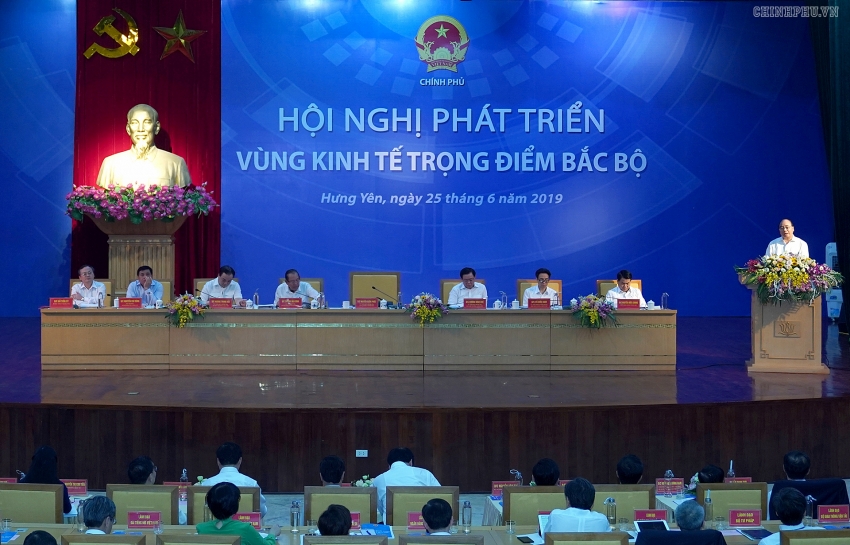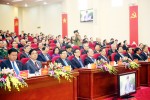Vietnam seeks to increase economic efficiency of northern hub
 |
| Prime Minister Nguyen Xuan Phuc speaking at the conference |
The event, which attracted the participation of Prime Minister Nguyen Xuan Phuc, deputy prime ministers and leaders of ministries, cities, and provinces, as well as domestic and international businesses, focused discussions on solutions to sustainable investment attraction, logistics services, and human resources development in the Fourth Industrial Revolution, transport, sci-tech and innovation, and tourism, among others.
Addressing the conference, Minister of Planning and Investment Nguyen Chi Dung said that together with improvements, the region now faces some problems that need to be solved to promote regional development in the future. Although service is the spearhead industry in the region, it has yet to grow sustainably. In 2016, the industry grew by 9.05 per cent. The rate, however, fell to 7.54 per cent in 2018.
The electronics industry only focuses on assembling and outsourcing with low added value. The development of hi-tech products aligning with the development of R&D centres remains weak. FDI projects concentrating on labour-intensive sectors and cheap labour advantages remain numerous. The Provincial Competitiveness Index (PCI) of some regional cities and provinces remains low and environmental pollution remains a hot issue.
Prime Minister Nguyen Xuan Phuc highlighted the development of the region. He also asked relevant ministries and regional localities to work closely on the possible solutions to increase the efficiency of regional co-operation.
“The northern key economic region should be the pioneer in the development of sci-tech and innovation activities, digital economy, circular economy, and green growth,” said the government leader.
Looking forward, the gross regional domestic product (GRDP) is aimed to reach 9 per cent in 2016-2020, while GRDP per capital will increase to $5,500. In addition, the northern key economic region's export turnover will make up 32 per cent of the country total by 2020, while the number of trained workers will rise to 80-85 per centby 2020. By next year, 98 per cent of urban solid waste, and 97 per cent of medical waste will be treated, while more than 90 per cent of industrial parks and export-processing zones will have standardised concentrated wastewater treatment facilities.
The northern key economic region comprises of seven cities and provinces – Hanoi, Haiphong, Quang Ninh, Hai Duong, Bac Ninh, Hung Yen, and Vinh Phuc – with a total GDP making up 32 per cent of the country’s and annual export turnover accounting for over 30 per cent of the country’s total.
Over the past years, the region has made great achievements, contributing significantly to the national social-economic development. In particular, transport network has been developed significantly, helping boost connectivity among regional localities. Big expressway projects include the Hanoi-Haiphong, the Hanoi-Cau Gie-Ninh Binh, the Hanoi-Thai Nguyen, the Hanoi-Lao Cai, the Ha Long-Haiphong expressways, while airports such as Noi Bai, Cat Bi, and Van Don and important seaports such as Lach Huyen and Cai Lan provide important regional and global connectivity.
In the 2016-2018 period, the GRDP grew 9.08 per cent on average, while GRDP per capita rose from $4,164 in 2016 to $4,813 in 2018, which is 86 per cent higher than the country’s average.
The regional economic structure changed positively towards increasing the contribution of non-agricultural sectors. The industry and construction sectors continue to be the pillars of regional development, attracting many big investment projects focusing on Hanoi, Bac Ninh, and Haiphong. In 2016-2018, these two regional industries contribute nearly 40 per cent of the country’s GDP, focusing on key industries such as electricity, electronics, automobile manufacturing, shipping, textile and garment, and supporting industry.
What is more, the business climate has improved. Regional foreign direct investment (FDI) inflows in 2016-2018 ranked second nationwide, just behind the southern key economic region with the total registered capital of $32.1 billion, or 27 per cent of the country’s total.
Healthcare, education, and environmental protection have also improved. Specifically, in 2018 67.8 per cent of the regional workforce consisted of skilled employees, higher than the country’s 58.6 per cent average, with Hanoi and Hai Duong named among the localities having the highest numbers of skilled manpower. IT has continuously developed strongly, with the presence of leading international groups namely Samsung, LG, Canon, and Microsoft, thus contributing to increasing the added value of industrial products.
In the first five months of 2019, the growth momentum continued. FDI reached $7.025 billion, while the index of industrial production (IIP) increased from the same period last year. For example, the IPP of Haiphong ascended by 23.06 per cent, Quang Ninh by 13.26 per cent, and Hai Duong's by 9 per cent. Moreover, total retail sales and service revenue of the region were up 12.5 per cent on-year.
 | Quang Ninh urged to become northern economic growth hub Quang Ninh has targeted to become a regional high-quality tourism center and an economic growth hub in the North with synchoronized socio-economic and technical infrastructure ... |
 | Bridge project to connect northern economic triangle Deputy Prime Minister Hoang Trung Hai yesterday broke ground on the construction of Bach Dang Bridge and its connecting road. |
 | Door to open for more industrial park options in the northern economic engine Japan’s Sumitomo Corporation will expand Thang Long Industrial Park II for foreign investors seeking a place to drop anchor in Vietnam. |
What the stars mean:
★ Poor ★ ★ Promising ★★★ Good ★★★★ Very good ★★★★★ Exceptional
Related Contents
Latest News
More News
- PM orders investment model for North–South high-speed rail (December 22, 2025 | 17:43)
- First members of Danang International Finance Centre revealed (December 22, 2025 | 17:39)
- Securing capital and efficiency for Vietnam’s 2026-2030 growth ambitions (December 17, 2025 | 10:00)
- Driving double-digit growth through green and circular transformation in Vietnam (December 17, 2025 | 09:00)
- Vietnam bucking trend in the global M&A landscape (December 16, 2025 | 14:20)
- Vietnam’s green transition demands collective financial action (December 15, 2025 | 12:00)
- VIR workshop highlights capital and policy for sustainable development (December 15, 2025 | 11:00)
- National Assembly approves pilot mechanisms to accelerate major projects in Hanoi (December 12, 2025 | 11:29)
- Vietnam eases policy approval requirements, simplifies foreign and outbound investments (December 11, 2025 | 17:53)
- Unpacking new momentum in Vietnam’s M&A market (December 10, 2025 | 09:59)

 Tag:
Tag:























 Mobile Version
Mobile Version